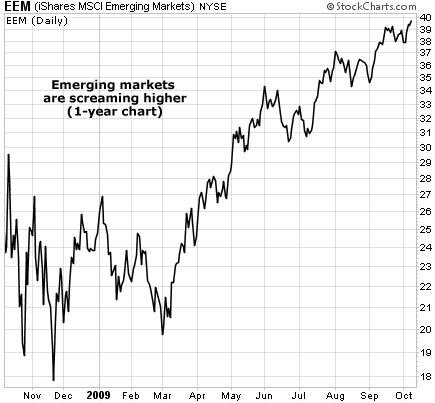| Home | About Us | Resources | Archive | Free Reports | Market Window |
America's Huge New Source of OilBy
Saturday, October 10, 2009
Mexico's colossal Cantarell field was once the second-largest oilfield in the world...
Cantarell funds 40% of Mexico's annual budget. Those petro-dollars paid for universities, built a $12 million sports stadium in Chihuahua, erected a giant flagpole in Nuevo Leon, remodeled churches in Yucatan, and constructed swanky government offices in Oaxaca. But according to a recent Wall Street Journal article, oil production from Cantarell peaked in 2005 and has fallen 75% since then. The golden goose is a dead duck... and its decline cost the government $14 billion this year. The same thing is happening in Indonesia, Iran, and Venezuela. Indonesia went from a proud member of OPEC to a net oil importer. Venezuelan production peaked in 1997 and is down 27% since then. Iran's production peaked in 2005, but has only fallen 2% so far... The worst is yet to come there. A lot of factors contributed to the undoing of these great oilfields – bureaucratic mismanagement and socialist daydreaming are key culprits – but behind it all is a simple, unavoidable fact of geo-engineering. That fact is going to make a few energy investors rich... Here's why: Oil recovery comes in three stages: primary, secondary, and tertiary. The early part of oil production flows under the natural pressure of the field – the iconic gusher of the oil industry. Oil escapes into the well, where it can be pumped to the surface. That's easy work. But primary production will only get about 10% of the oil in the field to the surface. Eventually, production exhausts the field's natural pressure. Then the engineers begin to replace the natural pressure by pumping water or natural gas into the field. That allows the companies to recover 20% to 40% of the oil left in the field. But it also means 60% to 80% of that oil remains trapped underground in so-called "depleted" fields. Tertiary recovery, or enhanced oil recovery (EOR), employs more sophisticated techniques to recover another 25% of the original oil in place. That means companies can recover 50% to 100% as much oil as the field originally produced. When you consider the U.S. has pumped 75 billion barrels of oil since 1977... that means, conservatively, we could recover another 35 billion barrels of oil from known fields. A lot of the big oil companies scrapped their EOR plans in the '80s, when the price of a barrel of oil wallowed in the teens. Now that oil is back up around $70, EOR is viable again... and it represents a huge "new" source of oil. EOR companies in the U.S. spend between $20 and $25 per barrel to produce light, sweet crude oil. That's in line with the industry's average cost to find and develop each barrel of oil. And it's well below the cost of developing fields offshore or in tar-sand deposits. Right now is a terrific time to buy these kinds of oil plays. On average, the market values oil companies at about $14 per barrel of reserves. But you can buy EOR companies for half that – about $7 per barrel of reserves. You see, most oil companies are valued on their "proven" reserves, meaning these oil holdings have been scrutinized and can be "economically and legally produced under existing economic and operating conditions." That's the SEC's standard: that the reserves can be produced today. But by definition, most of the oil reserves held by EOR firms can't be produced today... That's why these companies are using unconventional techniques. EOR companies have to describe them to investors as "probable" reserves. And the market doesn't pay for "probable" – certainly not nearly as much as it does for proven. The market distinction between proven and probable reserves suggests probable reserves are more risky, that maybe there isn't as much oil as the company says. But the fact is, this isn't speculative drilling in virgin territory. Domestic EOR companies are working in 100-year-old oilfields that have been measured, assessed, assayed, developed, and produced over and over. Everyone knows the oil is there. As soon as the rigs start pumping out petroleum, the SEC's bureaucrats can no longer ignore those reserves. The EOR companies can shift them to the "proven" category, and the market will respond by bidding up the value of those barrels. Oilfield reclamation technology is actually the future of the entire U.S. oil industry. It's safe, inexpensive, and will get cheaper over time. According to a 2006 study for the Department of Energy, the U.S. has about 210 billion barrels of oil that it can recover using EOR techniques. That's nearly 10 times today's proven reserves. With prices so low, now is the time to buy these companies. Out of fairness to my S&A Resource Report subscribers, I can't reveal the names of my favorite EOR plays. But I can point to new technology like EOR to remind folks that the world still has a tremendous amount of oil waiting to be unlocked. It's simply taking more innovation to find it. The winners of that innovation race will make for terrific speculations. Good investing, Matt Badiali P.S. I devoted the entire September issue of my S&A Resource Report to the tiny handful of companies with big EOR exposure. As their reserves move from probable to proven, I think shares will quickly double. If oil prices climb higher, even bigger gains will come. You're welcome to check out this research with our money-back guarantee. More details here.
Further Reading:
China's New Gold Rush Market NotesTHE REBOUND TRADE IS SCREAMING
|
In The Daily Crux
Recent Articles
|


